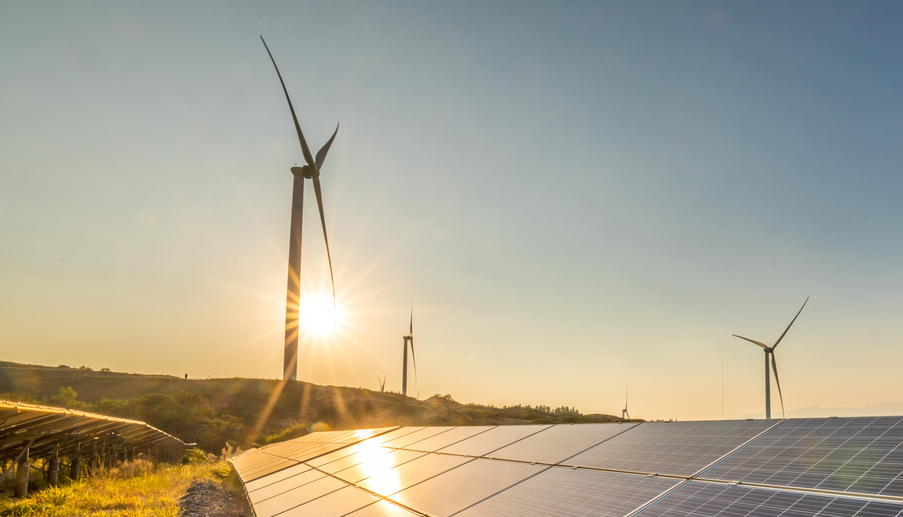31 March 2025
Infrastructure
August 12, 2024
Private capital crucial for US infrastructure
An influx of private capital is helping bridge funding gaps across a range of vital infrastructure projects in the US. NAB’s Eli Davis and Sarah Elliott explore the opportunities for investors.
By Corporate and Institutional Banking

Despite material US government investment to address the country’s growing infrastructure needs, there remains a significant funding gap to be overcome to help enhance economic and social wellbeing for the next decade and beyond.
A recent report from the American Society of Civil Engineers puts this gap as $US2.9 trillion[i] across a range of vital infrastructure sectors to 2033, assuming expenditure continues at the current expanded baseline rather than falling back to pre-2022 levels.
While government and other stakeholders all have an important role to play in tackling America’s burgeoning infrastructure needs, private capital has emerged as being uniquely positioned to leverage its ample financial resources, operational expertise and deep banking relationships to drive innovation and get projects built.
This industry trend has seen US-based infrastructure funds raise more than $US314 billion[ii] over the past five years, significantly outpacing the capital raised over the same period from 2014.

The opportunity today exists for this funding to be deployed for upgrades and improvements across sectors including transportation, water and wastewater systems, mobility, digital infrastructure and renewables.
For renewables in particular, we have recently seen an increase in deployment of private capital into the sector, driven by broader market trends including:
- Government policies and incentives, such as the Inflation Reduction Act at the federal level;
- Technological advancement, which continues to improve the efficiency and cost-effectiveness of renewable energy sources;
- Corporate customer demand from companies which have committed to climate and sustainability targets and need renewable power to help achieve them; and
- The rapid growth of energy-intensive data centres which further incentivises businesses to find alternative sources of energy.
The US fund inflows include capital from Australia as investors are increasingly drawn by the scale of the asset classes and diversified alternative investment opportunities available today.
Investing in US infrastructure can also help diversify Australian superannuation fund portfolios geographically, reducing concentration risk while providing stable and predictable returns from a large economy with significant growth opportunities.
Australia is the world’s fifth largest superannuation or pension market with $A3.9 trillion[iii] in total assets, and funds increasingly seeking offshore opportunities to deploy capital.
The NAB Super Insights Report 2023[iv] found the funds surveyed expected to increase their relative exposure to unlisted international infrastructure, international property and private credit over the following two-year period.
The cohort of 41 superannuation funds in the 11th biennial study held approximately $A1.57 trillion (47.8% of total assets) in offshore investments, including international equities, fixed interest, property and alternatives.
Bank support
A key part of NAB’s long time presence in the US has been supporting the leading global infrastructure funds and their investments through the provision of both fund and project financing.
Private capital sponsors will frequently put in place fund-level bank facilities to provide immediate liquidity which allows the fund to seize investments quickly without waiting for capital calls for investors.
This can assist funds with investments in real assets which have substantial upfront capital outlays, including renewables projects.
Bank facilities are also used to issue letters of credit (LCs), which can help enable project financing, for example by providing Standby LCs as a form of security to asset level lenders that the borrower will meet its financial obligations, or Performance LCs issued to ensure that the project sponsors meet project milestones.
The most frequent products used in this space are:
- A subscription line, which is an investor recourse loan where lenders have a secured position against high-quality institutional investor uncalled capital and collateral accounts;
- Net asset value (NAV) facilities, which are reliant on portfolio investments coverage and associated cash flows. These structures are particularly useful for open-ended funds and require a diverse asset portfolio, with a minimum number of assets, inclusion criteria and concentration haircuts; and
- Fund level FX lines, to protect the underlying investment value from adverse currency movements and help lock in exchange rates to minimise the impact of currency fluctuations on cash flows while stabilising returns for investors.
While hedging strategy varies, we increasingly see managers seeking longer-dated FX trades to align with the long-term nature of the infrastructure investments. Other approaches include actively rolling hedges early to manage unrealised mark-to-market and staggering maturities over multiple dates to smooth cash flows. Share class hedging is also used to protect the currency value of a specific share class in a fund for those who are investing in their home currency. This has proved an attractive product for fund managers who offer investors a hedged sleeve which aims to protect returns against fluctuation in exchange rates. Alternatively, Australian superannuation funds manage their currency exposure themselves via FX Forwards (most common), FX Options and Non-Deliverable Forwards (NDFs).
At the asset level, private capital sponsors are also continually looking to bolster their investments by procuring debt for their platform companies. The use of bank debt meaningfully adds to the capital stack and supports investment returns.
Debt facilities can be used throughout the life cycle of a project, starting with early-stage equipment procurement and running all the way through the operational phase. NAB is active in asset-level financing and has a long history of providing LCs, construction debt and term financing.
Both subscription finance and early-stage renewable construction facilities heavily use the banking market, given the nature of the staggered draws, and in the case of fund finance, the multicurrency options.
On the real asset side, once the project reaches a certain scale and has stable cash flows, financial sponsors can tap into debt capital markets for term financing to align with the long operational periods of these assets. This is common across all sectors, with the renewables sector likely to become an active user.
Fund finance is more typically aligned with the banking market, but a notable trend is that certain rating agencies are developing methodologies to rate these vehicles, with insurers and private equity managers themselves said to be looking closely at opportunities in this space.
Infrastructure opportunity
With the high level of capital raised but yet to be deployed, coupled with large federal fiscal deficits and constrained budgets at the state and local level, it would appear that private capital is set to remain an ongoing and important source of funding to close the investment gap for at least the near-term.
Through decades of experience supporting private capital investment in this sector, NAB has honed its expertise and produced positive outcomes for a wide range of stakeholders. As the pace of investment accelerates, we see prospects for further collaboration across the key areas outlined below.
- Renewable energy: NAB can work with clients to help finance development, equipment supply, construction and the operations of highly capital-intensive renewable projects over the transition. To date, NAB has financed more than 200 renewable energy transactions globally, committed over $A16.8 billion to renewable project funding and is recognised as Australia’s leading bank for project finance to the global renewable energy sector[v].
- Digital infrastructure: The digital landscape is quickly evolving and private capital has embraced the trend through significant investments in platform companies that build and manage data centres and fibre networks. Meeting ongoing and vast capex needs will require a substantial amount of bank financing along with access to the capital markets through pathways including US Private Placements (USPPs) and securitisation.
- Transport infrastructure: The efficient movement of people and goods remains a core requirement to any economy, with significant upgrades needed for logistics, rail, roads, ports, bridges and more. Bank financing will remain relevant as assets are privatised and/or public-private partnerships are developed. NAB has a long track record of supporting transport infrastructure globally, offering valuable experience for clients as they increase investment in the sector.
- Fund finance and related markets activity: NAB is a leading fund finance provider for infrastructure funds, having led and participated in subscription and NAV facilities for some of the largest global managers, who are actively deploying into Australia, the US and across the globe. NAB also provides competitive solutions to fund managers and Australian investors seeking to manage currency risk. In particular, NAB’s strong external rating assists us in being an attractive counterparty for LC issuances and in the FX market.
While the upcoming November 2024 US election and any ramifications for the sector need careful monitoring, it is worth noting that federal influence is just one part of a complex regulatory landscape, with significant variations in state incentives and regulatory policy.
Heading further into the year, it’s clear the funding task remains vast, with private capital having a crucial role to play to future-proof America’s infrastructure needs and enhance economic and social wellbeing for the next generations.
We look forward to continuing our support for customers as they make these important investments to provide amenity and opportunity for a sustainable future for communities they serve.
- Eli Davis is NAB’s Head of Specialised and Acquisition Finance US.
- Sarah Elliott is NAB’s Executive, Fund Sponsors, Strategic Investors and Alternative Assets.
Endnotes
[i] 2024-Bridging-the-Gap-Economic-Study.pdf (infrastructurereportcard.org), opens in new window
[iii] Super Statistics – ASFA The Voice of Superannuation since 1962, opens in new window
[iv] Super Funds continue to increase allocation to international assets: NAB report – NAB News
[v] Rankings based on IJGlobal League Table MLA, Renewables, both cumulative data from 1 January 2010 to 30 September 2023 and for the 12 months ending 30 September 2023.
Infrastructure


